Last week, I got an interesting assignment from my boss: find a way to introduce Agile/Lean to a management group in the form of a retrospective meeting so that they can start their Agile/Lean transition by finding gaps in their organization. When I started to prepare for this meeting I thought that this particular group should do their work according to the Lean principles and forget about Agile for a while. I could write another blog post about the reasoning - I don’t want to go into too much detail now -, but in a nutshell, I wanted them to do a real top to bottom transition and I felt that the Lean approach is more suitable for this than Agile, because Lean builds from the top and Agile raises issues from the bottom. I also felt that we’d be able to start with a more complicated exercise right away, so I decided not to bring any well known ones and put together a Lean exercise for them. The exercise consisted of four different tasks:
-
Do the value stream mapping of your organization
-
Show how the information flows through the organization
-
Find out which phase is the most valuable and which generates most of the waste
-
Generate an improvement queue based on the findings
I have to mention that we did the original exercise a bit differently than I’m describing below. This is because I learnt a lot while doing the exercise and have since made changes to the original idea as a result.
Value Steam Mapping of the Organization
If you are following the Lean principles during your work, then you may be familiar with the value stream mapping technique. It was introduced by Toyota in order to see the supplier chain in their manufacturing processes. However, in software development, it represents the different development phases, their order and how they interact with each other. The result of the value stream mapping is the flow - this is the same flow we visualize in Kanban.
![]() Doing the value stream mapping means that you take a piece of paper, start thinking about what kind of phases you have in your organization and note them down. When you are done, you connect these phases with arrows showing how they are connected. If you know any information (e.g. a short description what the phase is about, the name of the people who are involved) about a certain phase, you write it on the paper close to the phase it belongs to. That’s it.
Doing the value stream mapping means that you take a piece of paper, start thinking about what kind of phases you have in your organization and note them down. When you are done, you connect these phases with arrows showing how they are connected. If you know any information (e.g. a short description what the phase is about, the name of the people who are involved) about a certain phase, you write it on the paper close to the phase it belongs to. That’s it.
Alone and Backwards
So, the first task is to do the value stream mapping alone and to do it backwards! It is important to do it alone, because the participants must express their views and ideas without being influenced by other participants who might be their supervisors for instance. I’ve observed in the past that managers didn’t really open up while their boss was around, so it is highly critical to do this first step alone.
![]() Doing this task backwards is also highly important. I observed that people know a lot about how to start things, but sometimes they have problems with finishing them. So if they start in the normal way, they spend a lot of time at the beginning of the flow, dig really deep, but will end up having less time for the end of the flow. If you change the order of things, then they’ll have more time to think about the phases that they don’t know very well. Additionally, based on my experience, in most of the cases the waste is generated at the end of the flow. So again, value stream mapping: to be done alone and backwards.
Doing this task backwards is also highly important. I observed that people know a lot about how to start things, but sometimes they have problems with finishing them. So if they start in the normal way, they spend a lot of time at the beginning of the flow, dig really deep, but will end up having less time for the end of the flow. If you change the order of things, then they’ll have more time to think about the phases that they don’t know very well. Additionally, based on my experience, in most of the cases the waste is generated at the end of the flow. So again, value stream mapping: to be done alone and backwards.
In the pictures below you’ll see four different phases with their connections and some side-notes:
#### 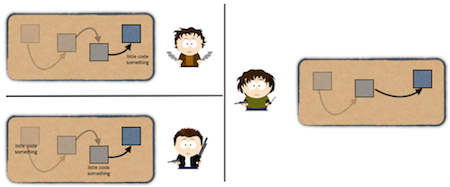
When the participants are done with the task - give them about 15 minutes for a middle sized organization - ask them to take their drawings, put them together and draw a new one based on their notes. Again, do the drawing backwards, but this time they all have to work together!
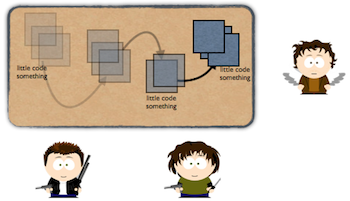
As you can see one of the participants has a phase missing from his paper, and they also don’t share the same notes. This is a start, because this means that they see the same organization differently, and there we have our first gap. We had the same situation during our meeting and it was good to see how they helped each other to clarify their different views and opinions. Facilitating this phase is very important, because
-
the bigger boss shouldn’t influence the others, and
-
there isn’t a lot of time to do this, so the group has to focus
How the Information Flows
At this point we have the flow, which is great, but let’s see how the information flows. This is the next task: enhance the flow so that it is visible which phase generates information and where that information lands. In this case it doesn’t matter where the group starts the work. They can move either forwards or backwards. The reason why the information flow has such power is because people usually connect phases without any deeper thought, just because “they are connected, don’t you see?”, but if you ask them to draw arrows which represent the flow of the information, you’ll see a completely different flow, like in this case:
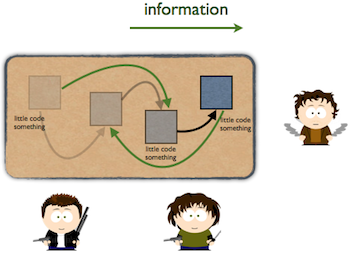
It turned out that there were two sources and two destinations. It was worth talking about the mechanisms in the flow again: how come we have a working organization, but there are phases that don’t know too much about the previous and following phases? Where is the feedback?
The goal of these powerful questions is to have a better and more accurate flow, plus to know more about the possible gaps. Updating the flow with the information shouldn’t take more time than the previous exercise. Let’s say you gave the group 10 minutes to draw the common picture, then the information enhancement should not be more than 7-8 minutes.
Finding the Value and the Waste
Now we have a quite accurate flow. The next task is to examine all the phases and have notes on the value of a phase and the kind of waste it generates. Do the task again alone and backwards. If this part proves to be too difficult, then it is enough to collect issues related to a certain phase. As you can see, the group found a lot of issues at the end of the flow:

The participants should read their notes out loud and put them under the proper phase. If the same issue appears again, just group them together. At this stage 5 minutes alone work and 30 minutes of talking should be enough. You’ll need more time for the second part of this task, because there will certainly be discussions and conversations about the issues. Keep in mind that the task is about collecting issues not solving problems. That’s the next task.
Improvement Queue
It is not enough to be aware of the problems in an organization, something has to be done to solve them as well. This makes an organization Lean: discover an issue, find the root cause and solve it! So the last task is to categorize and analyze the findings and come up with a queue for improvements:
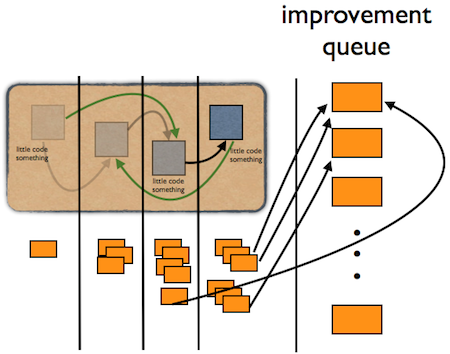
In the example above, the same problem appeared in different phases and it got to the top of the queue. It is common in organizations having just started an Agile/Lean transition for different issues in different phases to have the same root case. In such situations it is enough to have one work item for one root cause. When the queue is completed - meaning that it is filled and prioritized -, then the team can start working with the root cause analysis of the first improvement.
Conclusion
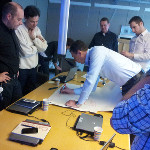
If you start a transition, it is very important to know every possible detail about your organization, because if you start to change and optimize in the wrong place you’ll end up doing more harm than good. The value stream mapping and the value and waste discovering tasks help you to find the areas needing your attention the most. The rule of thumb is to find the area which is the most problematic from the whole organization’s point of view and work on that. Everything else you are doing is a local optimization which won’t do too much good if you consider the whole organization.
The management group liked the exercise, there were some good conversations about the “doing things backwards” approach, however, the “finding the value and waste” task wasn’t that obvious to everybody. I should have explained it better and in more detail. Anyway, we had a productive two-hour long session and we managed to put together a list of work items which the group could start working on. Now comes the hard part for them: pull and solve the first work item.
I hope that you like this exercise and will give it a try. If you do so, please share your experiences in the comments below.
comments powered by Disqus